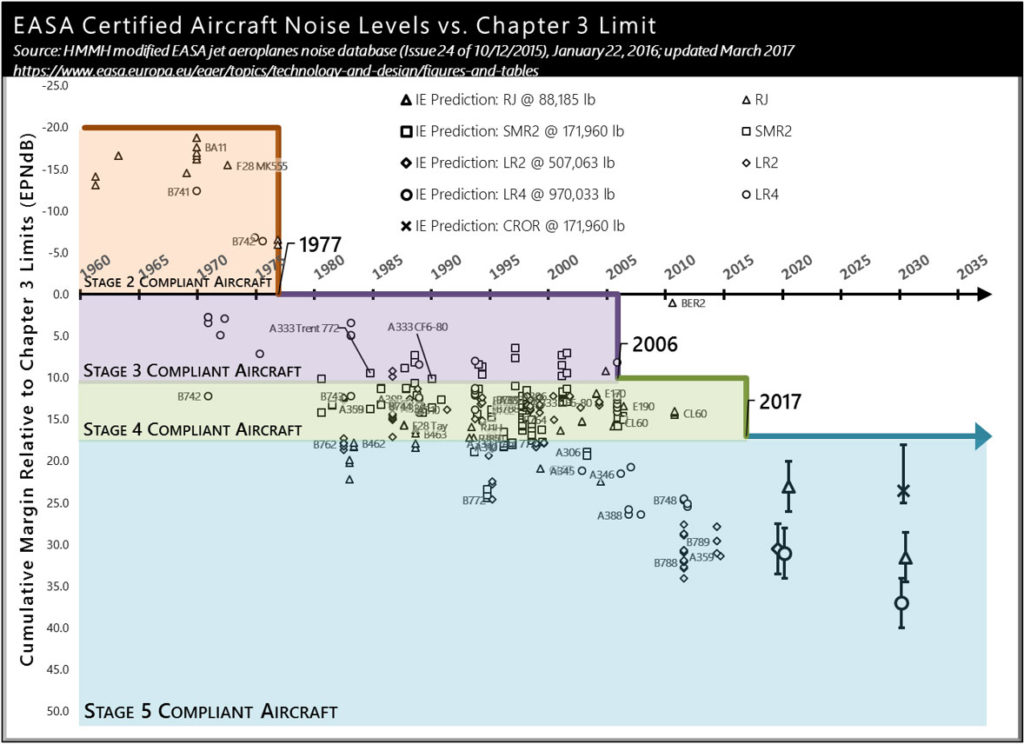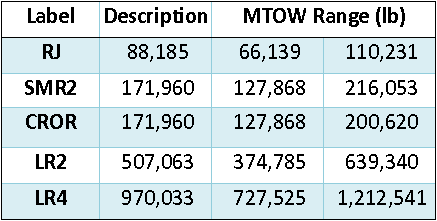Stage 5 Aircraft Noise Standards Approved in US – What does it mean for airports?
10.25.2017 | HMMH |On October 4, 2017, the Federal Register published a new noise standard for newly certified large airplanes.[1] The noise standard, Stage 5, applies to large jets with a Maximum Takeoff Weight (MTOW) greater than or equal to 55,000 kg manufactured after December 31, 2017. Jets with a MTOW of less than 55,000 kg will need to adopt this standard by December 31, 2020. This is in correlation with the ICAO Chapter 14 noise standard, adopted July 14, 2014, for the purpose of ensuring efficiency for aircraft manufacturers in certifying their aircraft. In short, Chapter 14 and Stage 5 include the same requirements in their standard to reduce any extraneous cost or effort by requiring aircraft manufacturers to comply with two separate standards.[2]

Figure 1: EASA Certified Aircraft Noise Levels vs Chapter 3 Limit Source: HMMH modified EASA jet aeroplanes noise database (Issue 24 of 10/12/2015), January 22, 2016; updated March 2017 http://bit.ly/2iwzgu6
The new Stage 5 standard requires a cumulative reduction of 7 EPNdB (Effective Perceived Noise Level, in decibels) from Stage 4 standards, which correlate to ICAO’s Chapter 4 standards. Chapter 4 or Stage 4 standards, adopted in 2006, required a cumulative reduction of 10 EPNdB from the Chapter 3 limit. Therefore, Stage 5 compliant aircraft require a cumulative reduction of 17 EPNdB from the Chapter 3 limit. Figure 1 shows the different aircraft Stages versus the Chapter 3 (Stage 3) limit as well as some of the different aircraft types that fall into each Stage’s noise standard currently. Table 1 (below) provides contextual information regarding the labels shown in Figure 1 (above).
For Stage 4 and Stage 5 requirements, the calculation of noise margins involves utilizing microphone locations at three places, which correspond to Chapter 3 noise limits. The cumulative result of subtracting the measured noise levels at three microphone locations from the limits determines whether an aircraft meets Stage 5 requirements.

Table 2: Analysis of Number of Jet Aircraft with a MTOW greater than 55,000 kg, Manufacturers, and Stage 5 Compliance Source: EASA, June 2017, http://bit.ly/2gAa7uc
As Figure 1 shows, many aircraft currently in operation already meet Stage 5 requirements. Table 2 shows aircraft with a MTOW of greater than or equal to 55,000 kg, where future iterations of the aircraft types produced by these manufacturers will need to meet the Stage 5 noise standard beginning on December 31, 2017. Currently, approximately one third of these aircraft meet the Stage 5 noise standard and their manufacturers are Airbus and Boeing.

Figure 2: Summary of Stage 5 Noise Standard Compliance by Manufacturer and Number of Aircraft Types Source: EASA, June 2017, http://bit.ly/2gAa7uc
Figure 2 (above) shows the number of aircraft types by each manufacturer that meet the Stage 5 noise standard currently, displaying whether all, the majority, a partial amount, a minimal amount, or none of that registered aircraft of meet the standard. Figure 3 below breaks this information down by aircraft type.

Figure 3: Stage 5 Noise Standard Compliance by Aircraft Type and Manufacture for Jet Aircraft with a MTOW of greater than or equal to 55,000 kg Source: EASA, June 2017, http://bit.ly/2gAa7uc
[1] The Stage 5 Noise Standard was originally proposed by the FAA on January 14, 2016.






